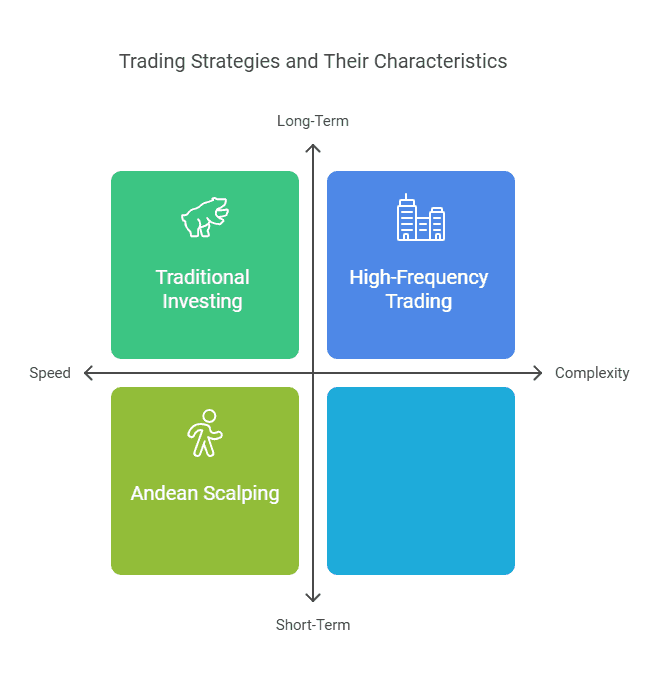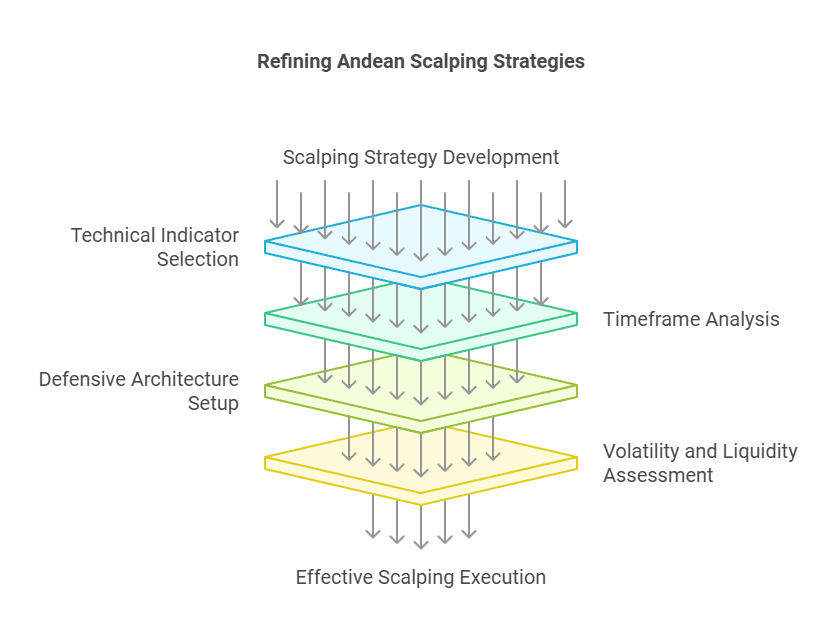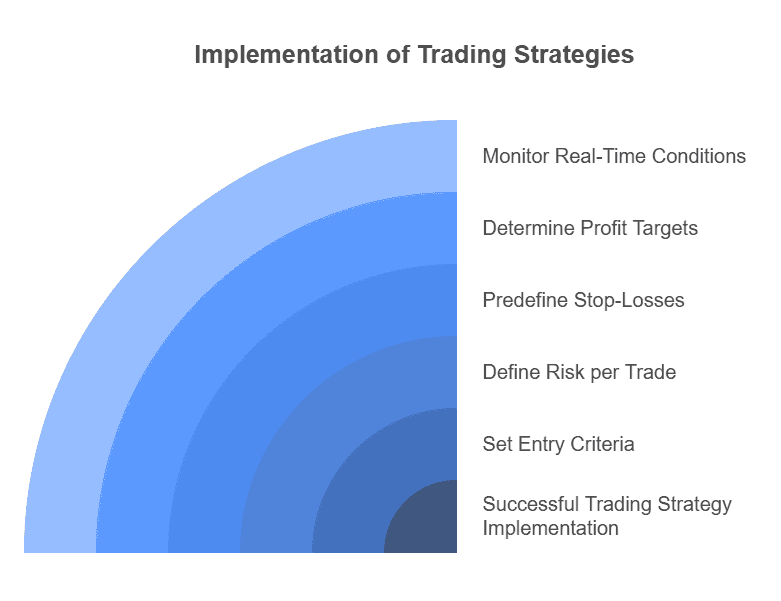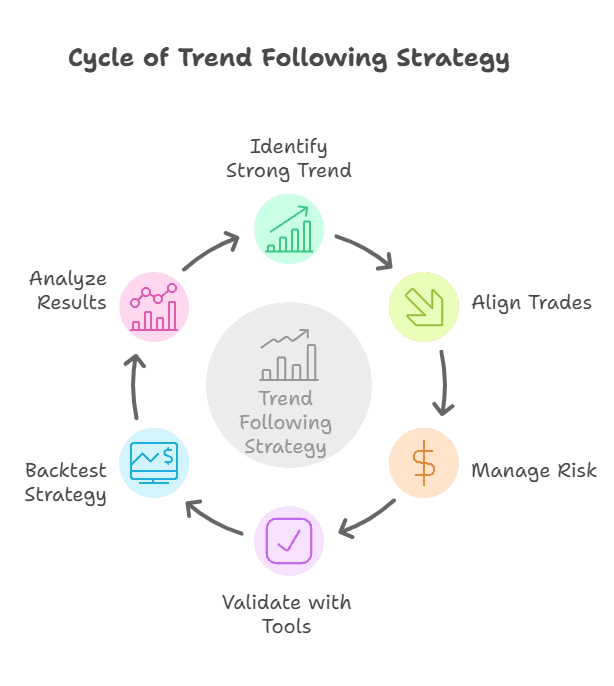Table of Content
Andean Scalping Guide: Maximize ROI with 3 Proven Backtest Examples
By Vincent NguyenUpdated 338 days ago

Andean Scalping is a fast-paced trading approach designed to capture small price movements with minimal holding times. Many traders find it appealing because short, frequent trades can yield meaningful returns when managed correctly. In this beginner-friendly guide, we will explore why scalping is so popular, how to set up trades for maximum ROI, and which market trends typically favor short-term strategies. We will also discuss ways to minimize false signals and manage risk through a defensive architecture of rules. By the end, you’ll have a strong foundation for testing and implementing Andean Scalping in various markets, including those with bullish price variations or bearish price variations.
Yet, before diving in, it is important to acknowledge the breadth of modern trading methods. Traditional long-term investors often examine previous studies or even bioarchaeological studies of market data—“excavating” old price movements—to find patterns. Others look for evidence of warfare between bulls and bears in historical charts. Traders also observe the development of trading tools like high-frequency trading algorithms that can exploit microsecond price changes. In contrast, scalping is more like a lightweight, swift expedition. It’s not always about building massive public architecture or ceremonial architecture of complex strategies; rather, it’s about a nimble approach that leverages short bursts of opportunity.
With that in mind, let’s explore the essential elements of Andean Scalping. We’ll touch on core technical indicators, special attention to bear component market conditions, and tips for mitigating risk using strong risk management practices.
What Is Andean Scalping?
Andean Scalping focuses on rapidly entering and exiting positions within minutes or even seconds. It uses basic indicators and Exclusive indicators, including the Andean Scalping indicator if available, to measure small upward and downward price variations. Scalpers typically aim to profit from quick bursts of momentum by capturing many trades throughout the day. This method relies on technical indicators that track minute fluctuations in bullish component or bearish components.
How It Differs from Other Strategies
1. Frequency of Trades: Scalpers often place multiple trades in a single session. Some even approach high-frequency trading territory.
2. Narrow Profit Targets: Unlike swing traders, scalpers have minimal thresholds for their trades. They might only aim for a few ticks above the closing price.
3. Risk Tolerance: Because positions remain open for such short periods, traders often set very tight stop-losses. They also rely on quick exits if a dominant component in market trends shifts unexpectedly.
Short Note on Bear and Bull Components
- Bear Component: Represents bearish price variations, indicating when sellers might dominate.
- Bull Component: Aligns with bullish price variations, showing when buyers control the market.
These components can overlap as a dominant component changes over minutes or hours. Traders who follow Andean Scalping seek to move in and out during each minor swing.
Key Elements of Andean Scalping
Executing Andean Scalping effectively demands a mix of solid technical knowledge and a disciplined mindset. This includes understanding the Implementation of Trading Strategies, testing with paper trading, and applying relevant trading rules to avoid major drawdowns. Below are several key elements to focus on.

1. Technical Indicators and the Andean Scalping Indicator
Most scalpers rely on technical indicators to guide their entries and exits. Some traders use a Dynamic Price Oscillator or moving averages as basic indicators. Others use an Andean Scalping indicator, an experimental signal tool that combines green line signals with momentum checks. Though relatively new, it offers guides for price movement in short intervals. Be mindful of false signals that occur during choppy conditions.
Why Indicators Matter:
- They help identify bullish price variations or downward price variations.
- They provide objective signals rather than subjective guesses.
- They can reduce confusion in rapidly changing markets, if used wisely.
2. Timeframe and Market Trends
Scalping thrives in a fast-paced environment. Traders often watch the 1-minute or 5-minute chart to track the current trend and any variations of trends. Quick shifts in the bear component market or bull component market call for razor-sharp reflexes.
Key Considerations:
- Shorter Timeframes: Lower intervals mean you’re more likely to catch abrupt moves.
- Closing Price: The final quote on each candle can signal momentum shifts.
- Market Overlaps: Forex sees overlapping sessions. Stocks have pre- and post-market activity.
3. Defensive Architecture for Entry and Exit
A “defensive architecture” in trading refers to how you protect your positions. Think of it as a fortress protecting your capital:
- Stop-Loss Placement: Set protective orders to limit losses if price moves against you.
- Take-Profit Targets: Estimate price upper thresholds to lock gains promptly.
- Andean Scalping Sell Signal: Even the best setups can reverse. Learn to exit when your system flashes a sell signal.
In some ways, you build a risk shield similar to ancient architecture styles that fortified dwellings. However, rather than guard against evidence for warfare, you guard against sudden market swings.
4. Volatility and Liquidity
Liquidity ensures you can open and close trades swiftly, while volatility fuels opportunities for quick profits. Markets with the best combination of liquidity and price movement often yield better scalping conditions.
Markets Ideal for Andean Scalping:
- Major Forex Pairs (EUR/USD, GBP/USD)
- Highly Traded Stocks (Large-cap equities with consistent volume)
- Popular Cryptocurrencies (BTC, ETH, especially during peak trading hours)
EUR/USD 45 MIN Strategy - FinexBOT
This strategy uses RSI, CCI, and Williams %R to identify overbought and oversold conditions in the EUR/USD pair. It opens buy trades when RSI is below 25, CCI is below -130, and Williams %R is below -85. Sell trades are opened when RSI is above 75, CCI is above 130, and Williams %R is above -15. Stop Loss is set at 0.45%, and Take Profit at 1.2%.
EUR/USD 45 MIN Strategy - FinexBOT
AMC Entertainment Holdings, Inc. (AMC)
@ 5 min
1.17
Risk Reward29.50 %
Total ROI360
Total TradesRisk Management and Defensive Architecture in Scalping
Whether you use Andean Scalping or another swift strategy, you must build a solid foundation for risk control. This foundation should guard against massive losses when the market turns. Many experienced traders also review earlier study data to see how certain trades performed in the past. In addition, they examine evidence of warfare between bulls and bears, hoping to refine their approach and dodge catastrophic errors.
1. Position Sizing and Stop-Losses
- Small Position Sizes: Avoid overexposing your capital in a single trade.
- Stop-Loss Placement: Keep it tight to control potential damage from sudden downward price variations.
- Paper Trading: Use a simulated environment to test how effectively you manage risk. This practice helps refine your reaction to an experimental signal, such as the Andean Scalping indicator flashing a sell.
2. Creating a Dominant Component Watchlist
Some traders build a watchlist of assets that consistently show a dominant component—be it bullish or bearish. By focusing on certain pairs or stocks, you can better predict their minor fluctuations and reduce the likelihood of false signals.
Benefits of a Curated Watchlist:
- Minimizes information overload.
- Lets you specialize in reading that asset’s behavior.
- Helps you tailor your indicators and trading rules.
3. Implementation of Trading Strategies with Defensive Steps
- Use “Trailing Stops”: If the price moves in your favor, adjust the stop-loss to lock in profits.
- Intraday Monitoring: Keep an eye on each closing price of a 1-minute or 5-minute candle. Sudden shifts can point to reversing market trends.
- Refine Over Time: The best scalpers treat each trade as part of an ongoing experiment. They note every outcome for continuous improvement.
Andean Scalping in Different Market Conditions
Andean Scalping can adapt to a variety of market environments. Traders often focus on high-liquidity assets with substantial intraday movements. However, scalpers can still succeed during lower-volatility sessions if they apply strict rules and watch for brief bursts of activity. This flexibility arises from the strategy’s core principle: capturing quick profits whenever reliable signals appear.
1. Spotting Bullish and Bearish Components
Scalpers monitor bullish price variations and bearish price variations throughout each trading session. A brief switch to a bear component market might require immediate exits to avoid a sudden drawdown. In contrast, detecting a new bull component could mean placing a trade as soon as the Andean Scalping indicator or another momentum tool flashes a green line signal.
- Bullish Swings: Occur when the dominant component in the market points upward, supported by consistent buying pressure.
- Bearish Swings: Happen when selling pressure dominates, often characterized by downward price variations and a shift below key moving averages.
2. High-Volatility vs. Low-Volatility Phases
- High-Volatility Markets: These present more profit opportunities for Andean Scalping, but also carry higher risk of sudden reversals. Traders must stay alert for false signals and place tighter stop-loss orders.
- Low-Volatility Sessions: Scalpers might find fewer trades in calmer markets. In these periods, patience is essential. Smaller moves can still be capitalized upon if you maintain discipline.
3. Adjusting to Closing Price and Current Trend
Monitoring each candle’s closing price helps confirm whether the current trend is still valid. A final tick above a resistance level may indicate continued bullish momentum, whereas a sharp drop at the closing price might confirm a reversal. In either case, adapting your Andean Scalping approach to the variations of trends is crucial for consistent results.
4. Defensive Architecture for Different Conditions
- Choppy Markets: When price whipsaws around a midpoint, place trades only if your basic indicators confirm strong momentum.
- Trending Markets: Ride the wave using short pullback entries or breakouts, always ready to exit if the dominant component weakens.
- News-Driven Volatility: Major announcements can spark unpredictable jumps. Either seize these opportunities with extra caution or wait until the dust settles.
Building Your Andean Scalping Strategy: Implementation and Development
A well-structured approach combines the right tools, strict trading rules, and a dash of flexibility. Below are key considerations when developing your own scalping playbook.
1. Start with Paper Trading
Before risking real funds, practice with paper trading on a demo account. This step allows you to test how your chosen indicators—be they basic or Exclusive—perform under real-time conditions. You can also see how your system reacts to the sudden shifts in bearish components or the surge of a bullish component during high-liquidity hours.
Why Paper Trading Is Essential:
- Builds confidence in your Andean Scalping entries and exits.
- Reveals weaknesses in your defensive architecture before live trading.
- Lets you refine your reaction to experimental signals, especially if you are using a proprietary or newly developed tool like the Andean Scalping indicator.
2. Combine Technical Indicators with Market Context
Using purely mechanical signals may lead to overtrading or ignoring bigger market trends. Integrating fundamental or macro context can help filter out false signals. At the same time, keep in mind that Andean Scalping relies on speed, so do not overcomplicate your approach with excessive data.
Consider These Factors:
- Earnings Releases or Economic Announcements: Catalysts that cause big swings or highlight a change in the bear component market or bull component market.
- Market Correlations: Some assets move together or in opposite directions. Spotting these patterns can give early warnings about potential reversals.
3. Dynamic Price Oscillator and Advanced Tools
The Dynamic Price Oscillator can help gauge market momentum. Traders frequently overlay it with a short-term moving average or an indicator in markets that pinpoints momentum shifts. By analyzing momentum peaks and troughs, you can estimate price upper targets for scalping. This synergy often produces clearer guides for price movement when combined with an Andean Scalping Sell signal or a green line signal for buys.
4. Implementation of Trading Strategies in Live Markets
Successful Implementation of Trading Strategies requires discipline and focus. Once you’ve validated your system through demo accounts and data-backed analysis, consider the following steps to deploy it in live markets:
- Set Entry Criteria: Identify the triggers for a buy or sell (e.g., crossing above a moving average plus a spike in volume).
- Define Risk per Trade: Keep risk low, typically no more than 1–2% of your account balance.
- Predefine Stop-Losses: Use tight stops just below recent support or just above resistance to limit damage from unexpected bearish price variations.
- Determine Profit Targets: Aim for small, consistent wins. Exiting trades once you’ve secured a quick profit is the hallmark of scalping.
- Monitor Real-Time Conditions: Always be ready to pivot if the current trend shifts from bullish to bearish, or if new data emerges.

5. Development of Trading Tools
Modern trading platforms offer many advanced tools. Whether you build your own Andean Scalping indicator or modify existing indicators, remember to incorporate an architecture styles approach. Keep your system robust yet flexible, much like a well-designed building. If a new data feed or a specialized oscillator emerges, test it carefully before adding it to your everyday arsenal. Over time, you might refine a tool that better fits the bear component market or the bull component market you trade most.
3 Andean Scalping Backtests Example
Each backtest checks whether the method delivers a solid ROI under real-world conditions. Remember, these examples are simplified summaries. Actual testing often involves multiple runs to rule out randomness.
Backtest 1: Andean Scalping in a Forex Pair
Market & Timeframe: EUR/USD on a 1-minute chart
Indicators Used: Short-term moving average crossover, Dynamic Price Oscillator, and green line signals from an experimental signal module
Trading Rules:
- Buy if the price crosses above the moving average while the Dynamic Price Oscillator is positive.
- Place a stop-loss five pips below the candle’s low.
- Close the trade if the Andean Scalping Sell signal appears or if the oscillator turns negative.
Results: Over a two-week period, the strategy netted an approximate 5% gain on the account. About 70% of trades were profitable, demonstrating consistent performance during a bullish phase. Short bursts of volatility allowed multiple entries per session.
Takeaways: This backtest suggests Andean Scalping works well in liquid Forex pairs where sudden moves can be captured. It also underscores the importance of tight stop-losses and disciplined exits to avoid major losses when the price quickly reverses.
Backtest 2: Andean Scalping on a Stock Index
Market & Timeframe: S&P 500 futures on a 2-minute chart
Technical Indicators: Andean Scalping indicator, short Exponential Moving Average (EMA), and a momentum oscillator
Scenario: Tested during a period with moderate volatility and significant intraday swings
Approach:
- Long Entries: Triggered when the dominant component was bullish, confirmed by a rising momentum oscillator.
- Short Entries: Activated when the index displayed a bear component pattern, typically indicated by the Andean Scalping indicator turning red and the momentum oscillator dipping below zero.
- Stop-Loss Placement: Just above or below the candle that triggered the entry.
- Take-Profit Ranges: Set to capture a 0.5% index move before closing the trade.
Results: The backtest captured frequent mini moves of 0.3%–0.6%. Over a month, the ROI was approximately 8%. However, midday lulls led to some false signals. The presence of a robust defensive architecture helped minimize losses during those choppy phases.
Takeaways: Stock indices can be ideal for scalping because of their liquidity, but you must remain cautious around low-volume windows. Shorter sessions, like the morning and afternoon rush, often yield better conditions than the quieter midday period.
Backtest 3: Andean Scalping on a Cryptocurrency Pair
Market & Timeframe: BTC/USDT on a 1-minute chart
Indicators Used: Dynamic Price Oscillator, standard RSI, plus a custom tool that combined basic indicators with candlestick patterns
Methodology:
- Implementation of Trading Strategies that triggered a buy when RSI and the Dynamic Price Oscillator aligned above key thresholds.
- Stop-Loss: Set 0.5% below entry to guard against rapid downward price variations.
- Exit Rules: Sell if RSI fell below 50 or if an Andean Scalping Sell signal emerged.
Outcome:
- Total of 20 trades in one week.
- Success Rate: Around 65%.
- Net ROI: Roughly 6%.
Crypto markets are highly volatile, so these trades saw big gains in short bursts. However, there were also a few trades that hit stop-losses quickly when the market reversed. The intense unpredictability of BTC amplifies both potential rewards and risks.
Conclusion
Andean Scalping is a dynamic short-term trading approach that empowers you to capture quick price movements in any market environment. By combining strong defensive architecture, precise technical indicators, and a keen awareness of bull and bear components, you can maximize your ROI while keeping risks under control. Test your strategy with paper trading, refine your trading rules, and use clear signals to confirm entries or exits. Over time, you will gain the confidence to handle false signals and abrupt shifts in momentum. If you remain disciplined and adapt to changing conditions, you can seize numerous intraday opportunities with Andean Scalping.



